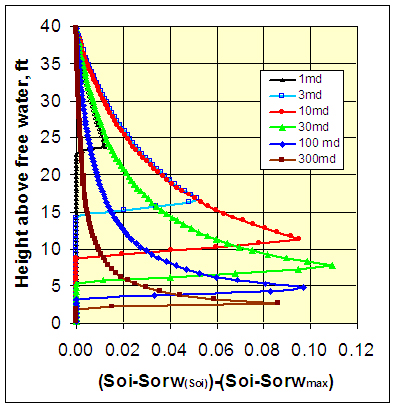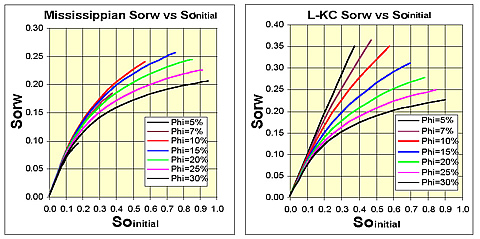For many shallow-shelf carbonate reservoirs in the United States, basic petrophysical properties (e.g., porosity, absolute permeability, capillary pressure, residual oil saturation, resistivity, and relative permeability) vary significantly horizontally, vertically, and with scale of measurement. In addition, many of these reservoirs produce from structures of less than 10-20 meters, and due to their position in the capillary pressure transition zone, they have variable initial saturations and relative permeability properties from the base to top of the reservoir. Rather than being simpler to model, these reservoirs challenge characterization and simulation methodology. As these reservoirs approach maturity and implementation of infill drilling and enhanced recovery programs are initiated or considered, access to and utilization of accurate relative permeability models is critical to accurately predicting recovery and therefore to successful reservoir management.
Results
Project products will include an online database and models for wettability and oil-water imbibition relative permeability for different initial saturations, obtained using representative oils and moldic carbonate lithofacies from Kansas fields (e.g., moldic Mississippian-age carbonates and oomoldic Lansing-Kansas City group limestones). Models developed to date predict imbibition oil-water relative permeabilities for different initial water saturations that define relations applicable to the transition zone-dominated reservoirs predominant in the Midcontinent. The practical importance and application of these relative permeability and wettability models is demonstrated by using reservoir simulation studies on theoretical/generic and actual reservoir architectures.
Benefits
For the shallow-structure, transition-zone dominated, carbonate reservoirs of the Midcontinent, avoiding over- or under-prediction of reservoir production performance is critical to successful improved/enhanced recovery program design, investment decisions, and efficient operations. The project will provide data and tools to help operators better characterize these reservoirs by providing more-accurate relative-permeability models that include effects of wettability, pore character, and starting saturations.
Reservoir performance modeling based on these realistic relative-permeability/capillary pressure inputs, as opposed to conventional inputs, will enable optimal improved and enhanced recovery program design. Improved reservoir modeling and management will lead to increased oil recovery that might otherwise be lost and may reduce improper abandonment, inefficient completion strategies, and excessive water production. Online databases and models will facilitate small, independent operator access and utilization of the results and could result in millions of barrels of additional oil production in Kansas and elsewhere in the Midcontinent region.
Summary
Collected oil samples from Arbuckle, Lansing-Kansas City, Mississippian, and Viola formations have had basic properties measured and exhibit a range of 16-44° in API gravity and a viscosity(µ)-API gravity (yAPI) correlation generally similar to the Beal (1946) correlation using a modified equation: ln(µ100) = -3.11+166.13/yAPI. Oil-brine interfacial tension at 60 °F (s60) ranges from 20-48 dyne/cm and is weakly negatively correlated with API gravity: s60 = 40.7–0.24 yAPI. Drainage and imbibition oil-water relative permeability measurements show that “irreducible” water saturation (Swi) increases with decreasing permeability and that residual oil saturation to waterflood (Sorw) increases with increasing initial oil saturation (Soi) for a given rock type, interpreted to be due to enhanced trapping by emplacement of oil in fine pores, and consistent with the Land (1971) equation.
For the carbonate rocks studied, utilizing the format of the Land equation, the trapping constant, C, increases with increasing porosity, resulting in less trapping. This relationship, when coupled with increasing Swi with decreasing porosity and permeability, results in a systematic dependence of Sorw on porosity/permeability and Soi. With Soi decreasing with depth in transition zones, proper modeling of relative permeability (kr) in the transition zone setting requires a suite of relative permeability curves that reflect changes in kr with changing Soiand Sorw. Utilizing a suite of kr curves in reservoir simulation shows that both oil and water recovery are greater than predicted from models utilizing kr curves with a constant Soi and Sorw. Two fresh cores obtained from the Arbuckle and Lansing-Kansas City exhibit reservoir rock properties typical of these formations in Kansas reservoirs. Preliminary wettability results indicate intermediate- to water-wetness.
Simple layered reservoir simulation models indicate that perforation strategy in transition zone intervals can be optimized by utilizing foot-by-foot relative permeability curves down through the transition zone and evaluating oil recovery income versus water-handling expense for each interval perforated. These models help to understand the sustained low oil production rate and the high water rates that are often observed in the Mississippian and Lansing-Kansas City reservoirs in Kansas.





